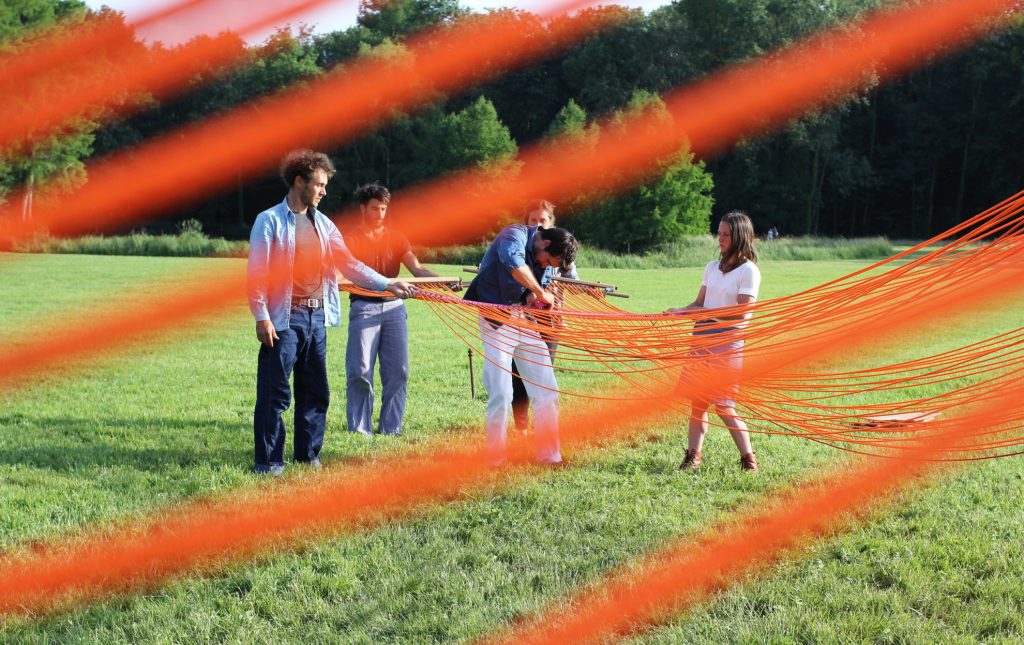
- News
Interview with Jordi Gali
Choreographer of Maibaum
Can you introduce yourself?
Born in Barcelona, I’ve moved very early to Brussels because of dancing. And I’m living actually in France where I set-up my working base.
Today the study of gesture is at the core of my artistic research.
My work proposes the emergence of ephemeral architectures.
In the processes of constructing architectural fictions I try to articulate the dramaturgy of a performative proposition.
We mostly perform our work on outdoors public spaces.
Do you notice a difference in audience between different countries and/or cities?
Of course we feel some differences playing here and there. But the most important for me is that in any case we address something specific to the heart and mind of a single person no matter its age, gender or race. Countries and cities are not so important at the end.
What is your opinion on the social relevance of theatre?
Nowadays I belief the role of Art and Culture in our societies is fundamental. It is still a protection against provoked fear, immoral hate and defeatism. Art in general and living arts specially remind us the importance of getting together, sharing a bit of life beyond any kind of cynicism.
What drives you to be creative?
Curiosity. The desire to understand is probably the strongest energy for me, even if sometimes it is leading me to destruction…
What role did theatre/dance have for you when you grew up?
From time to time I have the chance to be teaching to teenagers and young ones. I realise at that age some of them are really lost and trying to get their way. And I realise too how important it is at an early age to have strong motivations for anything, it is fuel for the engine. It makes you seek further from the end of your nose. It makes you fearless.
If you hadn’t become an artist, what would have been your profession?
I don’t think you become an artiste all at once. Every time you have to start from scratch, making sure you didn’t get lost on the way, not knowing where you are going. But it seems interesting to me to question what is art and what is not in any professional career, even for an Artist.
How do you create the shapes of your construction, how are they conceived? What would you say has been the inspiration for your installations?
It depends on the structure, sometimes it just happens… but most often shape is the result of a long process of empiric testing and failing. Drawing, trying and adjusting again and again. Ideas are worked out slowly for month and years. The most important is to realise what the problem is about. Then solutions can appear some times in a second, just in a glimpse.
Somehow inspiration roots itself in childhood, it is hard to say how…
What do you hope the audience sees in your “Maibaum”?
For more than ten years now I have been working on the relation between gesture and object. As a dancer at a certain point I couldn’t work anymore just with myself. By working with matter I wanted to become a conductive agent for the spectator. I was trying to bring its attention to something else than myself.
With Maibaum I guess it is still the same question. I hope the audience can find in our proposition something it is related to them self intimately, something about their own relation to the world surrounding us.
Where does a performance start for you?
Even if in our work we try to understand how quotidian and efficient gestures function, I would say performance starts just few minutes before the show. Even if bringing attention to details of every day’s life is important – healthy- Art and Life is not the same for me. Life will always be the hardest challenge.
Why is this old European tradition of the Maibaum of interest to you, and how is this reflected in the installation?
Traditionally the Maibaum is a celebration of life when springtime is back. It is a celebration of sex and dead, of nature. It is the occasion to get together and dance around the pole. So it becomes a symbol, a common project at the centre of all of us.
Would you recommend audiences to watch the performance for three consecutive hours? Why? Or why not?
The notion of time is relative. Things seem to go faster and faster and our feeling of losing time is growing and growing, endlessly. We are always in the rush for something, busy with so many solicitations…
In any case we will be there for the three hours, and you will be welcome even if you are there just for a minute.